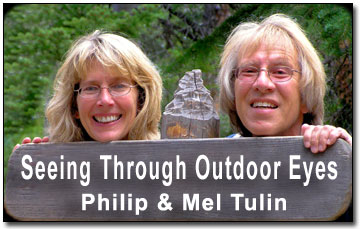|
When we lived on the East Coast, we were avid sea kayakers and enjoyed leaving very early in the morning when there was absolutely no wind (referred to as a “sea of glass”). We have also paddled down the coast of Kauai and Maui along side of the humpback whales, giant sea turtles, gray seals, harbor seals, etc. Now… what does sea kayaking have to do with On-The-Go Photography (OTG)? Well, there is a similarity.

Years ago, we met and became good friends with Derek Hutchinson, who is considered to be the father of modern day kayaking. He not only taught us how to become proficient sea kayakers using the correct techniques, but he also taught us how to become one with our kayak and the ocean. We learned that you just don’t grab on to the paddle, you hold it the same way that you would hold a bird’s egg. Everything he taught us was contrary to the way you would envision paddling a kayak. Your paddle and your kayak became an extension of yourself and when you were paddling in that “zone,” you never became tired. He taught us how to have all our needed equipment within arm’s length but yet our kayak deck was totally empty so that our paddles could be at the perfect height for paddling and for being prepared for any emergency situation. When you see Derek paddle in his kayak, it is like watching water ballet. It is magical and gives you an entirely different perspective of sea kayaking. He taught us to use all of our senses when we were out on the ocean. We wanted to replicate that same feeling with the use of our equipment when we were hiking and photographing. We wanted photography to become a part of our hiking experience, not to be a separate experience. We were able to blend photography with ocean kayaking when we paddled the shores of Monomoy Island where over 10,000 migrating birds on the shores were 10-20 feet away from our kayaks. The camera, the kayak and we were all part of that experience and nothing felt out of place. Now, we wanted to experience that same feeling combining photography, hiking, our backpacks, poles and boots. We didn’t want to lose that feeling of being on the trail when we had our photography gear with us. We wanted the camera to be an extension of our backpacks, our hiking poles and ourselves. But, unfortunately, there wasn’t a mentor who could guide us to our destination. So, we had to follow our own path and the result was On-The-Go Photography (OTG).
We will discuss wildlife and baseline in a future article, but it should be mentioned at this time to explain what happens with both kayaking and hiking. Baseline is when wildlife does what is natural for them during the day. When they stop doing their natural behavior, they are out of baseline. And when they are not in baseline and they are giving the voice of alarm, all of the wildlife within a certain radius knows. They listen and then they move on to safer areas depending on the alarm. Baseline, once understood by you, is common sense combined with observational skills. If you have your camera in your backpack and you have to stop, take your backpack off, unzip your backpack, and remove your camera… by that time the wildlife will be out of baseline. You have to become at one with nature and your camera has to be an extension of you. If you can not accomplish this, you will lose many photo opportunities.
There are only 4 ways of photographing wildlife. 1: Go to a wildlife sanctuary. 2: Set up a blind and wait until the wildlife approach you. 3: Carry around a monster 600mm-800mm lens with a tripod or 4: Hike along a trail with a small camera and have the birds and wildlife accept your presence. (This is our preference.) If we can photograph wildlife close by (and we are not placing ourselves in any immediate danger), then we not only will have the opportunity of taking great photographs, but we will also have an outdoor experience that we will remember for a lifetime.
When we are out on the trail, we have had countless experiences when the wildlife accepted our presence in their environment. When looking at some of our coyote photographs, people have asked us, “Did you use big lenses?” “No”, was always our answer. They always responded, “I never see coyotes this close.” In order to understand On-The-Go Photography, you have to learn the language of the birds (which will be discussed in another article). The birds always warn the wildlife in the area of potential danger. If you learn the language of the birds, you will understand and be able to use On-The-Go Photography.
We recently started at 9:00am to hike up to Mills Lake. On the way up, we passed a hiker who had hiked up by himself for a sunrise photograph of the lake. The snow was still 4’-5’ deep in many places on the trail and the last half mile was totally in the snow. As we passed the hiker, he said, “Boy, that hike was extremely frozen and slippery early this morning!” He has started so early that the trail was an ice skating rink and there were a couple of places where, if he took the wrong step, he would have slid down the snow bank into the river... possibly placing himself in terrible danger. We realize that many photographers have this approach when looking for the perfect photo opportunity. We are just offering another option for experiencing the great outdoors and taking some great pictures. If your goal is to obtain the best photograph possible and you don’t care about the journey, then do what you have to do to obtain the best photography results. For us, “The Journey Is The Reward”.
| 
